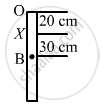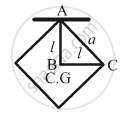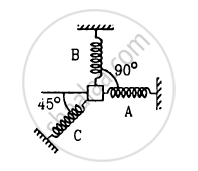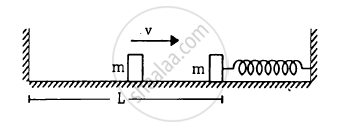Advertisements
Advertisements
Question
Find the time period of small oscillations of the following systems. (a) A metre stick suspended through the 20 cm mark. (b) A ring of mass m and radius r suspended through a point on its periphery. (c) A uniform square plate of edge a suspended through a corner. (d) A uniform disc of mass m and radius r suspended through a point r/2 away from the centre.
Solution
(a) Moment Of inertia \[\left( I \right)\] about the point X is given by ,

I = IC.G + mh2
\[= \frac{m l^2}{12} + m h^2 \]
\[ = \frac{m l^2}{12} + m \left( 0 . 3 \right)^2 \]
\[ = m\left( \frac{1}{12} + 0 . 09 \right)\]
\[ = m\left( \frac{1 + 1 . 08}{12} \right)\]
\[ = m\left( \frac{2 . 08}{12} \right)\]
The time Period \[\left( T \right)\] is given by,
\[T = 2\pi\sqrt{\frac{I}{mgl}}\] \[\text { where } I = \text{ the moment of inertia, and } \] \[ l= \text{ distance between the centre of gravity and the point of suspension . }\] \[\text {On substituting the respective values in the above formula, we get: }\] \[T = 2\pi\sqrt{\frac{2 . 08 m}{m \times 12 \times 9 . 8 \times 0 . 3}}\]
\[ = 1 . 52 s\]
(b) Moment Of inertia \[\left( I \right)\] about A is given as,
I = IC.G. + mr2 = mr2 + mr2 = 2mr2

The time period (T) will be,
\[T = 2\pi\sqrt{\frac{I}{mgl}}\]
\[\text { On substituting the respective values in the above equation, we have: }\]
\[T = 2\pi\sqrt{\frac{2m r^2}{mgr}}\]
\[ = 2\pi\sqrt{\frac{2r}{g}}\]
(c) Let I be the moment of inertia of a uniform square plate suspended through a corner.
\[I = m\left( \frac{a^2 + a^2}{3} \right) = \frac{2m}{3} a^2\]

In the
\[\bigtriangleup\] ABC , l2 + l2 = a2
\[\therefore l = \frac{a}{\sqrt{2}}\]
\[ \Rightarrow T = 2\pi\sqrt{\frac{I}{mgl}}\]
\[ = 2\pi\sqrt{\frac{2m a^2}{3mgl}}\]
\[ = 2\pi\sqrt{\frac{2 a^2}{3ga\sqrt{2}}}\]
\[ = 2\pi\sqrt{\frac{\sqrt{8}a}{3g}}\]
(d)
\[\text { We know }\]
\[ h = \frac{r}{2}\]
\[\text { Distance between the C . G . and suspension point }, l = \frac{r}{2}\]
Moment of inertia about A will be:
l = IC.G. + mh2
\[= \frac{m r^2}{2} + m \left( \frac{r}{2} \right)^2 \]
\[ = m r^2 \left( \frac{1}{2} + \frac{1}{4} \right) = \frac{3}{4}m r^2\]
Time period (T) will be,
\[T = 2\pi\sqrt{\frac{I}{mgl}}\]
\[ = 2\pi\sqrt{\frac{3m r^2}{4mgl}} = 2\pi\sqrt{\frac{3r}{2g}}\]
APPEARS IN
RELATED QUESTIONS
A copper metal cube has each side of length 1 m. The bottom edge of the cube is fixed and tangential force 4.2x108 N is applied to a top surface. Calculate the lateral displacement of the top surface if modulus of rigidity of copper is 14x1010 N/m2.
Which of the following example represent periodic motion?
An arrow released from a bow.
A particle executes simple harmonic motion with a frequency v. The frequency with which the kinetic energy oscillates is
A particle moves in a circular path with a uniform speed. Its motion is
The position, velocity and acceleration of a particle executing simple harmonic motion are found to have magnitude 2 cm, 1 m s−1 and 10 m s−2 at a certain instant. Find the amplitude and the time period of the motion.
Consider a simple harmonic motion of time period T. Calculate the time taken for the displacement to change value from half the amplitude to the amplitude.
A particle of mass m is attatched to three springs A, B and C of equal force constants kas shown in figure . If the particle is pushed slightly against the spring C and released, find the time period of oscillation.

The left block in figure moves at a speed v towards the right block placed in equilibrium. All collisions to take place are elastic and the surfaces are frictionless. Show that the motions of the two blocks are periodic. Find the time period of these periodic motions. Neglect the widths of the blocks.

A uniform plate of mass M stays horizontally and symmetrically on two wheels rotating in opposite direction in Figure . The separation between the wheels is L. The friction coefficient between each wheel and the plate is μ. Find the time period of oscillation of the plate if it is slightly displaced along its length and released.

The ear-ring of a lady shown in figure has a 3 cm long light suspension wire. (a) Find the time period of small oscillations if the lady is standing on the ground. (b) The lady now sits in a merry-go-round moving at 4 m/s1 in a circle of radius 2 m. Find the time period of small oscillations of the ear-ring.

A uniform disc of radius r is to be suspended through a small hole made in the disc. Find the minimum possible time period of the disc for small oscillations. What should be the distance of the hole from the centre for it to have minimum time period?
The maximum speed of a particle executing S.H.M. is 10 m/s and maximum acceleration is 31.4 m/s2. Its periodic time is ______
Which of the following example represent (nearly) simple harmonic motion and which represent periodic but not simple harmonic motion?
A motion of an oscillating mercury column in a U-tube.
When two displacements represented by y1 = a sin(ωt) and y2 = b cos(ωt) are superimposed the motion is ______.
A simple pendulum of frequency n falls freely under gravity from a certain height from the ground level. Its frequency of oscillation.
What are the two basic characteristics of a simple harmonic motion?
